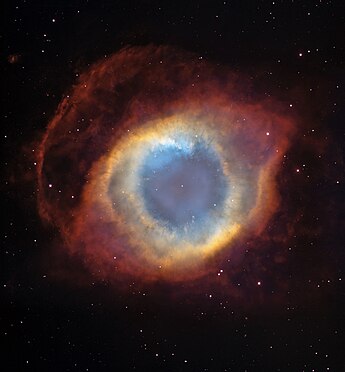IntroductionA star is a luminous spheroid of plasma held together by self-gravity. The nearest star to Earth is the Sun. Many other stars are visible to the naked eye at night; their immense distances from Earth make them appear as fixed points of light. The most prominent stars have been categorised into constellations and asterisms, and many of the brightest stars have proper names. Astronomers have assembled star catalogues that identify the known stars and provide standardized stellar designations. The observable universe contains an estimated 1022 to 1024 stars. Only about 4,000 of these stars are visible to the naked eye—all within the Milky Way galaxy. A star's life begins with the gravitational collapse of a gaseous nebula of material largely comprising hydrogen, helium, and trace heavier elements. Its total mass mainly determines its evolution and eventual fate. A star shines for most of its active life due to the thermonuclear fusion of hydrogen into helium in its core. This process releases energy that traverses the star's interior and radiates into outer space. At the end of a star's lifetime as a fusor, its core becomes a stellar remnant: a white dwarf, a neutron star, or—if it is sufficiently massive—a black hole. Stellar nucleosynthesis in stars or their remnants creates almost all naturally occurring chemical elements heavier than lithium. Stellar mass loss or supernova explosions return chemically enriched material to the interstellar medium. These elements are then recycled into new stars. Astronomers can determine stellar properties—including mass, age, metallicity (chemical composition), variability, distance, and motion through space—by carrying out observations of a star's apparent brightness, spectrum, and changes in its position in the sky over time. Stars can form orbital systems with other astronomical objects, as in planetary systems and star systems with two or more stars. When two such stars orbit closely, their gravitational interaction can significantly impact their evolution. Stars can form part of a much larger gravitationally bound structure, such as a star cluster or a galaxy. (Full article...) Selected star - Photo credit: NASA and ESA
Sirius is the brightest star in the night sky. With a visual apparent magnitude of −1.46, it is almost twice as bright as Canopus, the next brightest star. The name "Sirius" is derived from the Ancient Greek Seirios ("scorcher"), possibly because the star's appearance was associated with summer. The star has the Bayer designation α Canis Majoris (α CMa, or Alpha Canis Majoris). What the naked eye perceives as a single star is actually a binary star system, consisting of a white main sequence star of spectral type A1V, termed Sirius A, and a faint white dwarf companion of spectral type DA2, termed Sirius B. Sirius appears bright due to both its intrinsic luminosity and its closeness to the Earth. At a distance of 2.6 parsecs(8.6 ly), the Sirius system is one of our near neighbors. Sirius A is about twice as massive as the Sun and has an absolute visual magnitude of 1.42. It is 25 times more luminous than the Sun but has a significantly lower luminosity than other bright stars such as Canopus or Rigel. The system is between 200 and 300 million years old. It was originally composed of two bright bluish stars. The more massive of these, Sirius B, consumed its resources and became a red giant before shedding its outer layers and collapsing into its current state as a white dwarf around 120 million years ago. Selected article -Photo credit: NASA
In astronomy, stellar classification is a classification of stars based on their spectral characteristics. The spectral class of a star is a designated class of a star describing the ionization of its chromosphere, what atomic excitations are most prominent in the light, giving an objective measure of the temperature in this chromosphere. Light from the star is analyzed by splitting it up by a diffraction grating, subdividing the incoming photons into a spectrum exhibiting a rainbow of colors interspersed by absorption lines, each line indicating a certain ion of a certain chemical element. The presence of a certain chemical element in such an absorption spectrum primarily indicates that the temperature conditions are suitable for a certain excitation of this element. If the star temperature has been determined by a majority of absorption lines, unusual absences or strengths of lines for a certain element may indicate an unusual chemical composition of the chromosphere. Most stars are currently classified using the letters O, B, A, F, G, K, and M (usually memorized by astrophysicists as "Oh, be a fine girl/guy, kiss me"), where O stars are the hottest and the letter sequence indicates successively cooler stars up to the coolest M class. According to informal tradition, O stars are called "blue", B "blue-white", A stars "white", F stars "yellow-white", G stars "yellow", K stars "orange", and M stars "red", even though the actual star colors perceived by an observer may deviate from these colors depending on visual conditions and individual stars observed. The current non-alphabetical scheme developed from an earlier scheme using all letters from A to O; the original letters were retained but the star classes were re-ordered in the current temperature order when the connection between the stars' class and temperatures became clear. A few star classes were dropped as duplicates of others. Selected image - Photo credit: Hubble Space Telescope/NASA and ESA
A planetary nebula is an emission nebula consisting of an expanding glowing shell of ionized gas and plasma ejected during the asymptotic giant branch phase of certain types of stars late in their life. This name originated with their first discovery in the 18th century because of their similarity in appearance to giant planets when viewed through small optical telescopes, and is otherwise unrelated to the planets of the solar system. They are a relatively short-lived phenomenon, lasting a few tens of thousands of years, compared to a typical stellar lifetime of several billion years. Planetary nebulae play a crucial role in the chemical evolution of the galaxy, returning material to the interstellar medium that has been enriched in heavy elements and other products of nucleosynthesis. Did you know?
SubcategoriesTo display all subcategories click on the ►
Selected biography - Photo credit: Unknown artist, uploaded by User:Salvatore Ingala
Claudius Ptolemaeus (Greek: Κλαύδιος Πτολεμαῖος Klaúdios Ptolemaîos; c. AD 90 – c. 168), known in English as Ptolemy /ˈtɒləmɪ/, was a Roman citizen of Egypt who wrote in Greek. He was a mathematician, astronomer, geographer, astrologer and a poet of a single epigram in the Greek Anthology. He lived in Egypt under Roman rule, and is believed to have been born in the town of Ptolemais Hermiou in the Thebaid. He died in Alexandria around AD 168. Ptolemy was the author of several scientific treatises, at least three of which were of continuing importance to later Islamic and European science. The first is the astronomical treatise now known as the Almagest (in Greek, Ἡ Μεγάλη Σύνταξις, "The Great Treatise", originally Μαθηματικὴ Σύνταξις, "Mathematical Treatise"). The second is the Geography, which is a thorough discussion of the geographic knowledge of the Greco-Roman world. The third is the astrological treatise known sometimes in Greek as the Apotelesmatika (Ἀποτελεσματικά), more commonly in Greek as the Tetrabiblos (Τετράβιβλος, "Four Books"), and in Latin as the Quadripartitum (or "Four Books") in which he attempted to adapt horoscopic astrology to the Aristotelian natural philosophy of his day. In Almagest, considered to be one of the most influential scientific texts of all time, Ptolemy presented his astronomical models in convenient tables, which could be used to compute the future or past position of the planets. The Almagest also contains a star catalogue, which is an appropriated version of a catalogue created by Hipparchus. His Planetary Hypotheses went beyond the mathematical model of the Almagest to present a physical realization of the universe as a set of nested spheres. TopicsThings to do
Related portalsAssociated WikimediaThe following Wikimedia Foundation sister projects provide more on this subject:
Discover Wikipedia using portals |
























